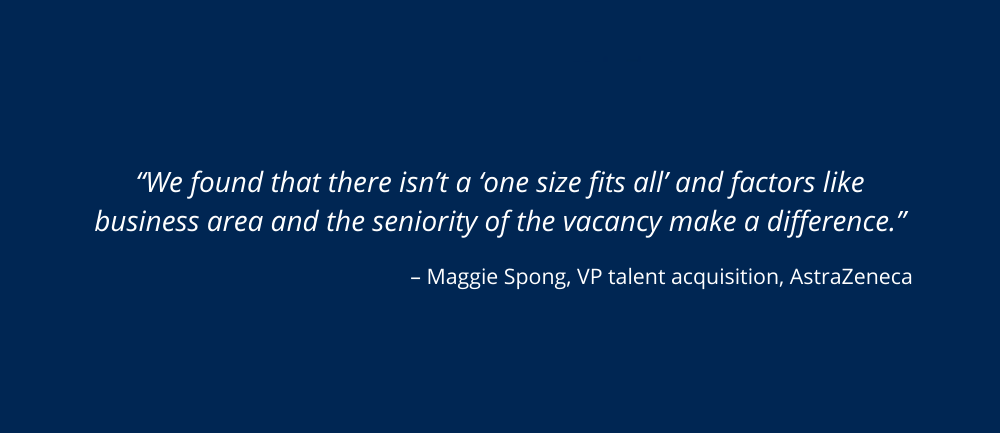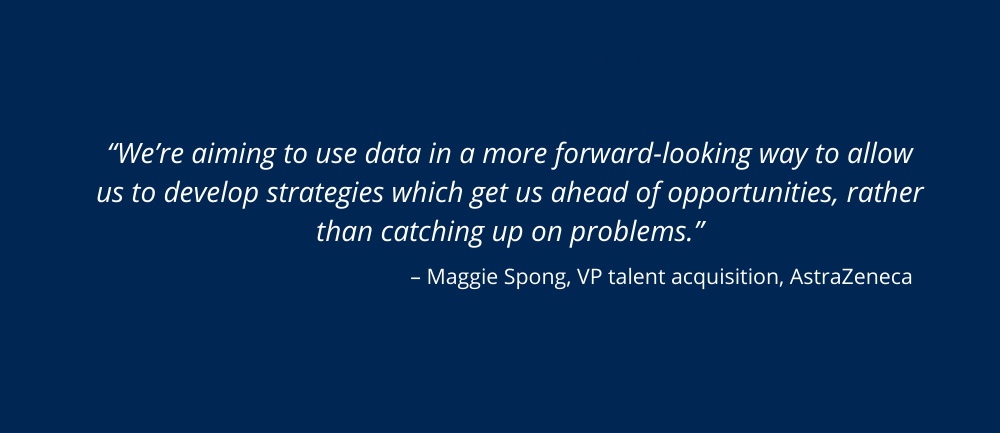-
Provided by

- Date published: Aug 26, 2021
- Categories
AstraZeneca’s AZD1222 vaccine has driven the UK’s response to the Covid-19 pandemic. Over 54 million doses of the vaccine, developed in tandem with researchers at Oxford University have been supplied to the UK since it was approved in December 2020, making it the most common vaccine in the UK by a considerable margin.
The vaccine has been extremely successful and has been produced at cost. However it has also required the Cambridge-headquartered company to recruit an army of specialist staff – a task made even more difficult by the restrictions of remote working.
In this case study, Maggie Spong, AstraZeneca’s vice president talent acquisition, explains how she and her colleagues have met this challenge – and how they have used this extraordinary situation as an opportunity to promote diversity throughout the company.
If you want to see how AstraZeneca’s brand has grown during Covid-19, Maggie Spong has a stat. She says that during 2020 the company’s attraction rate, a metric that judges its appeal to the brightest talent on the market, increased by 25%. People all around the world want to come aboard and take the fight to Covid-19.
But there’s another stat, too, one which illustrates the strain that Covid-19 has created. In the first seven months of 2021, AstraZeneca recruited 1,500 more people than they would have done in a normal year. When you consider that they usually hire 22,000 people in a given 12-month period, you get an idea of just how big the recruitment drive has been.
Maggie and her colleagues have raced to recruit skilled people in clinical development positions who can lead submissions to regulatory bodies, as well as operations employees to deliver the vaccine at scale. The talent acquisition unit has specifically sought out candidates with expertise in vaccines, virology and immunology within the pharmaceutical industry, a resource which was scarce even before the pandemic.
The challenge lies not only in finding experts with these scarce skills, but also adapting the interview process in a Covid-19 world.
Finding the right fit
For each position, candidates are screened by a recruiter, before being invited to a video interview to test their skills and their fit with the company’s values.
Depending on the candidate’s level, they may also be asked to undertake an interview with a business area vice-president. Candidates for some specific roles are required to pass through an assessment centre, which comprises hiring managers, peers, existing employees and talent acquisition partners. The goal is to assess candidates (often graduates) on a combination of values-based and technical interviews, presentations and group exercises.
Then there’s the second stage of the acquisition programme: an onboarding period designed to inculcate the company’s values and allow the new starter to hit the ground running – a particular priority at the present time.
Managers are encouraged to meet their new charges before they start, often several times. To help them deliver the best possible candidate experience, each manager is given a checklist of key behaviours and is required to read a standard onboarding document, which guides them on creating the right introductions for the new hire over their first few weeks. The new starters are also given a buddy, who can help them get acclimated to AstraZeneca and answer any questions they have.
Years of research
This hugely detailed process is underpinned by reams of research and investigation, designed to optimise both the output of the AstraZeneca managers and the experience for the candidate.
When Maggie and her team first mapped out their current talent acquisition model, they looked specifically at the volume of requisitions that each talent acquisition partner should manage at any one time.
“We found that there isn’t a ‘one size fits all’ and factors like business area and the seniority of the vacancy make a difference,” Maggie says. “However, across the board, we aim for our Talent Acquisition Partners to oversee 20-30 vacancies at any one time and to deliver between 65-100 hires per year.”
More recently, the focus has shifted to the candidate experience; in 2020, the talent acquisition team spoke to over 4,000 candidates across 18 countries. “This data has helped us to clearly define the expectations of our candidates and we’ve updated our process and standards accordingly.
“One example was about response times. We found that candidates expect – on average – to hear back after an initial application in around one week whereas our previous standards were four weeks. We now measure our candidate experience as part of our BAU (business-as-usual) and have data collection points across the entire candidate journey – including both successful and unsuccessful candidates – and this data will continue to inform our processes and standards.”

Digital drive
To deliver this quick, smooth process and minimise the burden on the acquisition managers, AstraZeneca has invested a huge sum of money in technology. Even without Covid-19, this would have been important. In the wake of lockdown, which scattered the talent acquisition team to all corners of the UK and Europe, it has become essential.
“Within a week of Covid-19 breaking out, we had pivoted to carrying out interviews and onboarding remotely,” Maggie recalls. The new operation, she says, is integral to the interview process and even more important at the onboarding stage, enabling managers to “mirror a face-to-face meeting as closely as possible.”
To further streamline the process, managers are able to access their training via a dedicated online portal, and the onboarding team is currently piloting a new technology called Eli, which strives to build understanding with new hires about AstraZeneca and its values.
Like many companies, AstraZeneca is also using gamification to energise its interview process and assess candidates who may be located on the other side of the world. In their assessment centres Maggie and her team have adopted Pymetrics, a tool which assesses a candidate’s credentials with 12 different challenges, collecting thousands of data points on metrics such as fairness, generosity and decision-making.
As well as providing rapid-fire data on a candidate’s abilities, this type of technology ensures that candidates have the digital skills that the vaccine programme demands. “We’ve been proactive with sourcing talent with [digital] capabilities and have developed bespoke campaigns to reach that audience,” Maggie says (in parallel with its recruitment drive, AstraZeneca has created a Digital Awareness Hub to upskill its existing employees).
Above all, these digital assessments are fair. They remove prejudice and preconception from the recruitment process and ensure AstraZeneca is as representative as it possibly can be.

Representing everyone
Indeed, it is clear that AstraZeneca has used the pandemic as a catalyst for change. As well as taking steps to meet the digital future, it has also attempted to make itself more diverse. With so many applications flooding in, the last few months have provided a prime opportunity to open up the talent pool.
“Diversity is one of our key requirements,” Maggie says. “It goes hand in hand with innovation, and it’s something we’ve practised for several years. Inclusion and diversity is built into our global standards.
“We aim for 50% male-female, and although we don’t have specific targets around ethnicity because it might not be possible in some areas, we aim to ensure that our workforce represents the communities we are based in. This balance is one of the goals of our interview process.”
The talent acquisition team employs a wide variety of recruitment channels including LinkedIn, job boards and referral programmes, and requires recruitment partners to do the same. They have successfully piloted using blind CVs to remove bias from their decisions when receiving applications in certain areas, and are looking to automate this more broadly.
Reflecting the technological advances made elsewhere in the recruitment project, a pair of razor’s-edge digital tools have been piloted to facilitate the diversity process: Mya, a conversational programme that screens early-stage candidates and coordinates interviews, and Textio, an augmented writing platform that roots out potentially problematic phraseology (the software is also used by Fujitsu, the subject of an earlier HRD case study).
But the key role is played by the hiring managers. As Maggie explains, this has been a subject of close attention.
“We train all our hiring managers on inclusion and diversity to ensure there’s no unconscious bias, using an online training platform. The training is compulsory, and it lasts about an hour. It’s a mixture of roleplaying, examples, multiple-choice… there are a lot of little tests.”
Exceptional progress
Of course, there have been challenges. “Candidate scarcity is always a problem when hiring for experienced pharmaceutical physicians and scientists,” Maggie explains. “This was exacerbated by the race to produce a vaccine, which meant this talent was a key priority for our competitors as well.”
But the issue of remote working during the lockdown has not presented any serious problems. In fact, Maggie says that the recruitment process has been just as effective..
“We’ve got great recognition from candidates to reflect this. We survey our staff and candidates regularly, and one of the things that has shown up in the past is that there’s sometimes a delay in the process of getting feedback.
“The percentage of candidates reporting this problem has fallen by around 20% since Covid and we will continue to take these improvements forward as we return to the office.”

Over the next few months, the talent acquisition strategy will be refined even further. Virtual interviews will remain the core of the strategy, although face-to-face will be phased in for certain candidates at the latter stages.
The key to this evolution is data. Maggie and her team will be drilling down into the numbers to look at the success of each hire source, gauge their ongoing attractiveness to potential hires and analyse the length of time it takes new hires to be promoted – a metric which gives an indication of the quality of new recruitments.
“We’re also working to identify more lead indicators. Traditionally, Talent Acquisition has reported on things like time to hire, cost of hire and source of hire. Many of these are lag indicators, meaning that – by the time we’ve spotted something – it’s already a problem.
“We’re aiming to use data in a more forward-looking way to allow us to develop strategies which get us ahead of opportunities, rather than catching up on problems.”
No-one knows when, or if, Covid-19 will be brought under control. But whatever challenges the pandemic throws up, AstraZeneca will be ready.

